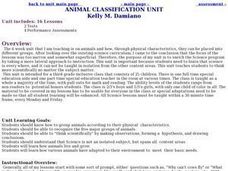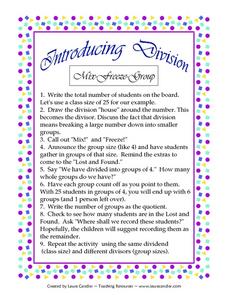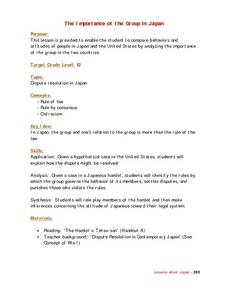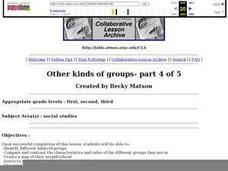Curated OER
Focus: "R" Is for Respect
Students examine how rules are important for both individuals and groups. They discover how rules are tools so that people can live and work together.
Curated OER
From Moo to You
Students listen to a story about cows and identify foods made from milk. They have a tasting party and practice a finger play called "Five Mugs of Milk."
Curated OER
Animal Classification Unit
Third graders study how to group animals by their physical characteristics. They examine how animals have adapted to have their needs met by the environment.
Curated OER
What Doesn't Belong?
In this "What Doesn't Belong" worksheet, students are given fifteen groups each containing three words. Students must determine which of the three words does not belong in the group.
Curated OER
Mix Freeze Group
In this mathematics worksheet, students write the total number of students written on the board. Then they draw a division house around that number and discuss breaking the number down into groups.
Curated OER
Compare Groups
In this mathematics worksheet, students identify various types of shapes shown. Then they circle the group with the most shapes. There are 8 problems to solve on the sheet.
Curated OER
Unlocking Whole Numbers
Fifth graders investigate three kinds of remainders, use computers and counters division mats to explore equal groups. In pairs, 5th graders solve problems at the computer. Notepad is used by the students to explain symbols, grouping,...
Curated OER
Types of Groups
Students are introduced to the various types of groups in a society. In groups, they create a chart showing the similarities and differences between primary, secondary, and reference groups. Using magazines, they cut out pictures...
Curated OER
The Importance of the Group in Japan
Twelfth graders discuss the importance of the group in Japan. In groups, they compare and contrast behaviors and attitudes of those in Japan and the United States. They are given a case to review and identify the rules by which the...
Curated OER
Where You Belong
Students identify different groups to which they belong, and use counting techniques to take a census of their family and class.
Curated OER
We Need All Five!
Second graders review foods and their groups. They discuss the reasons why they need to eat from all five food groups. They try to write using only a few of their five fingers to see what happens when you don't use all five fingers.
Curated OER
Arianna Travels the Orient Express
Fourth graders discuss how they eat when they travel. They resequence a letter that has been separated into pieces. They read the letter aloud, discuss the foods eaten by the writer and analyze whether she ate the right amount of food...
Curated OER
Food Model Mobiles
Students create mobiles that represent a day's intake or other criterion, such as healthy snacks, Milk Group foods, breakfast foods, etc.
Curated OER
Get a Feel for Food
Students describe the size, shape and feel of a food hidden in a "feely bag" and then select the Food Model from a group that corresponds to the food. In a tasting party afterwards, they sample the food and describe the color, taste and...
Curated OER
Examining the pilgrim characters in the Monkey King stories
Students examine the pilgrim characters in the Monkey stories with the help of a worksheet.
Curated OER
Other kinds of groups- part 4 of 5
Students compare and contrast characteristics of groups. Students create graphs using various symbols of different groups. Students make maps of their neighborhood 'groups'.
Curated OER
Teamwork Towers
Students, in groups, create a free standing tower of straws and pins in ten minutes. They view a video of the cooperative groups working and list the things they could do as individuals to improve the cooperative effort of their group.
Curated OER
Groups We Belong To
Learners think about and identify different kinds of groups. They see that people are born into certain groups and that they join others. They explore the circumstances that surround group affiliation and participation.
Georgia Department of Education
Ga Virtual Learning: Physical Science: The Periodic Table
This learning module allows students to use the organization of the periodic table to understand the element and their properties. By the end of the activity, students will be able to locate metals, nonmetals, and metalloids and the...
University of Texas
Inside Mathematics: Pam's Shopping Trip [Pdf]
This task challenges a student to demonstrate understanding of equal groups of objects to gain a foundation for multiplication.
University of Texas
Inside Mathematics: Sheeps and Ducks [Pdf]
This task challenges a student to use addition and multiplication to think about and calculate equal sized groups.
Other
American Medical Association
This resource is the homepage of the association responsible for licensing all medical education programs in the US, and setting the standards for medical education, practice, and research. Contains professional and educational resources.
Texas Education Agency
Texas Gateway: Periodic Table Families
Given descriptions or specific element groups, students will use a Periodic Table to relate properties of chemical families to position on the table.






















![Inside Mathematics: Pam's Shopping Trip [Pdf] Lesson Plan Inside Mathematics: Pam's Shopping Trip [Pdf] Lesson Plan](https://d15y2dacu3jp90.cloudfront.net/images/attachment_defaults/resource/large/FPO-knovation.png)
